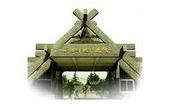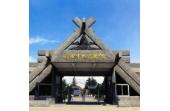Yangshao culture got its name from its discovering place. It is
also called colored pottery culture, specializing in crude pottery.
Lying on the mesa in the south of Yangshao village, the site is
besides Shao Mountain in the north, with river running around in
other three directions. It covers 300,000 square meters,with 2~4
meters thick of cultural modified soil.
In 1951, Institute of Archaeology, Chinese Academy of Social
Sciences, discovered the four layers in the cultural modified soil,
they are the middle period and later period of Yangshao culture and
early period and middle period of Longshan culture from bottom up.
During the 70 years since its discovery, the site has been explored
for three times. The mainly unearthed wares are
stonewares,bonewares, potteries and clamwares. Stonewares used for
farming like axes, shovels and chisels, those for hunting like
stone arrows and bullets, and those for spinning like spinning
wheels, bone needles, and bone spindles. People's daily appliances
at that time are mainly pottery, therefore, there are unearthed
pottery caldrons, jars, bowls, basins, cups, urns, crocks, etc. The
most attractive thing is the decorating patterns on potteries,
which have various forms of stripes, such as broadband stripes, web
stripes, petal-like stripes, fish-like stripes, chord-like stripes,
and geometrical patterns. These beautiful patterns reflect the
ancient people's intelligence and pursue of life's beauty. The
delicate colored pottery is a feature of Yangshao culture. There
are not many visitors at the site of Yangshao culture though it is
famous, because the local security measures are not very good. Now
many antiques are kept in Henan Museum and the Forbidden City.
Location: At Yangshao village, 9 kilometers away from Shengchi county in the
north in the city of Sanmenxia.











